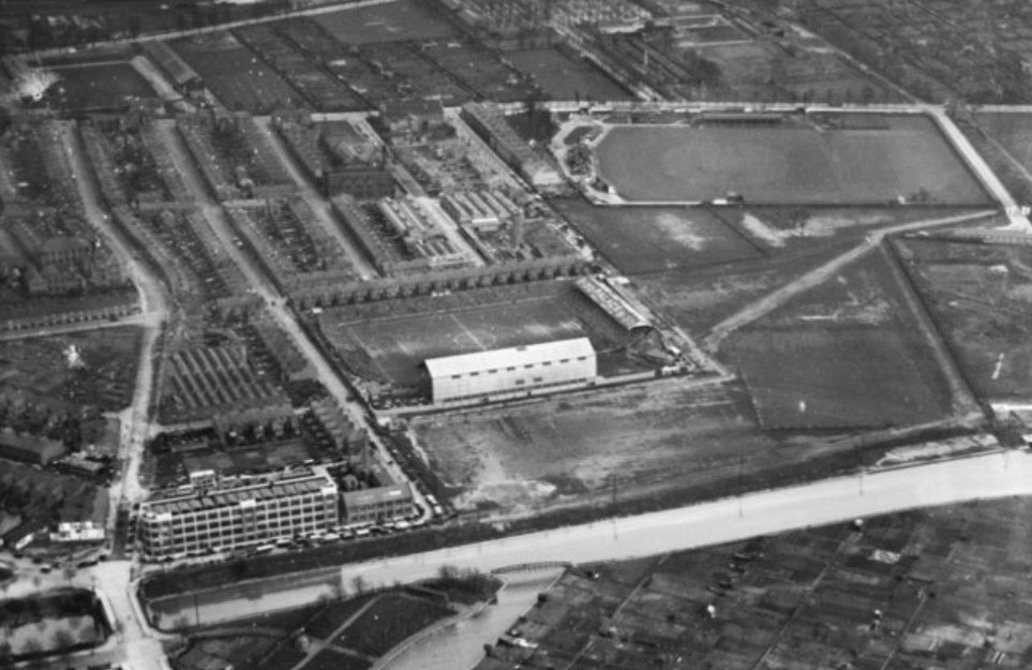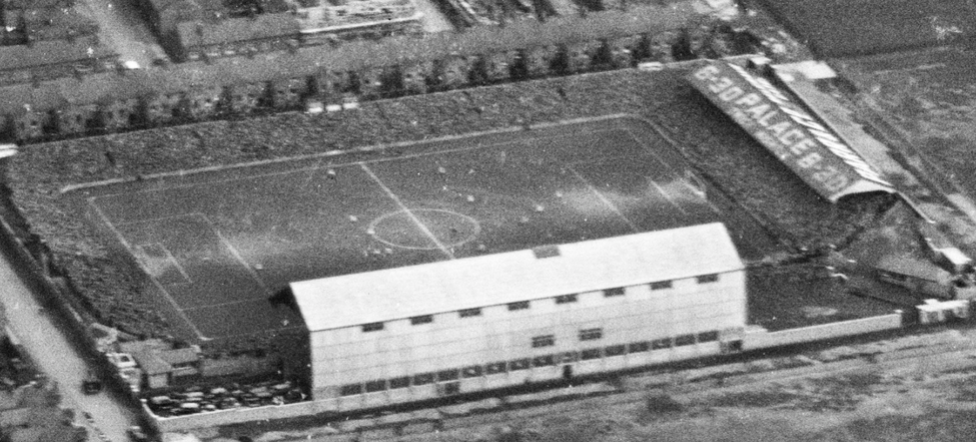A view from above: The remarkable story behind one Filbert Street photo
In the first of two historical articles in the run-up to this weekend’s clash with Fulham, an aerial view of Filbert Street takes centre stage.
This story has its origin in an archive of aerial photos on the Historic England website.
If you zoom in on the Leicester section and investigate, one image stands out – this amazing photo from 1923:
Such a wonderful view of the old place, and if you look closely, all sorts of interesting things become apparent.
First, the photo actually shows a match in progress:
What a scene that is - the Main Stand before the 'Wings' were added, and the old Spion Kop looking magnificent.
But is it possible to identify which match it is? Well, the detail on the website says it's from January 1923. We played three home games that month, two in the League, against Barnsley and Notts County, and one in the FA Cup, against Fulham. It's pretty clear that it's the Cup tie we're looking at, given how packed the terraces are, and what looks like a white shirted opposition. You can see the kits in this shot from the Daily Mirror:
The match was a quite an historic occasion. 'Que Sera Sera' was several decades in the future, but this was the first time we were dreaming of Wembley. The nation was already obsessed with Cup football, and with the new national stadium set to stage the Final, it just added to the excitement.
Contemporary match reports give a taste of the mood:
“Every type of vehicle capable of moving, from horse charas to Ford one-tonners, turned out to convey the hordes of Fulham fans from Leicester Station to the ground.
Others walked, and the path across the recreation ground was soon transformed into a sea of mud. Then crowds swarmed down each street in the "Nutteries" while vehicles dumped their passengers before returning for further loads.”
Zooming in to the photo again you can see, in what looks like a scene from Wacky Races, all those vehicles near the ground, next to the Liberty Building.
The Fulham fans would go home disappointed - we won 4-0, with genius Johnny Duncan getting two. Dreams of Wembley lived on...
But back to that aerial photo. Anything else to notice?
Top left in the original shot is the Tigers’ ground, and top right is a fine view of the Aylestone Road Cricket Ground, which Leicestershire used between the wars.
On the Historic England site, there is another photo from the 1920s which shows the cricket ground more clearly:
There's a match in progress here, too. Zoom in and you clearly see the umpires reaching the middle, with the fielding side behind them, and two batsmen walking down the pavilion steps.
Can we identify this occasion? Well, here we are given a precise date - June 10th 1927.
That was the final day of Leicestershire's game against Surrey in the County Championship. It was an exciting time for County. They'd had a wretched thirty years, finishing in the bottom half of the table every year but one. But going into this game they were suddenly second in the table behind Lancashire.
The sparse crowd reflects the state of the game on that final day. After Surrey built a large first innings lead we only had six second innings wickets left and were just four runs ahead. If we lost quick wickets it could be all over pretty quickly. In the end, the game was wrapped up by mid-afternoon, Surrey coasting home by 10 wickets.
So the archive gives us a precious insight into two separate sporting occasions from almost 100 years ago - Leicester City v Fulham in 1923 and Leicestershire v Surrey in 1927.
And this is where it gets truly remarkable, for there is one man who links the two events.
His name is Andy Ducat.
Have a look at this short video:
You might have spotted some key words there - like 'Fulham' and 'Surrey'.
After lifting the Cup for Villa in 1920, he played for Fulham between 1921 and 1924.
And here are the teams for the FA Cup match at Leicester in 1923:
You can see he was Fulham's number 4 - he was playing right half.
As a cricketer, Ducat played for Surrey for almost twenty five years before retiring in the late 1920s.
And this is the scorecard for their first innings at Leicestershire in 1927:
So he was taking part on both occasions.
Let's look at those photos again. It's impossible, of course, to pick him out in an aerial photo. Unless...
We know from the match report that Leicester were attacking the Kop in the first half, which is almost certainly when the photo was taken, given how early the light would start to fade in mid January. That means Ducat would have been playing on the side furthest from the Main Stand, close to the Popular Side (later the East Stand).
Look at the photo and while the blue shirts of Leicester are difficult to spot against the background, the Fulham players stand out, and are sticking fairly rigidly to their positions in an orthodox 2-3-5 formation. The player circled is in the right half position, and there's a high probability that is our man:
How about the cricket photo? Well, it shows the players entering the field on the last day, so it could be one of three moments:
a) The start of play, with Leicester 150-4 overnight
b) The start of the afternoon session, with Leicester 220-9
c) The start of Surrey's 2nd innings, the target 97
If it's either of the first two, then Ducat is one of the fielders in the group heading for the middle. If it's the other one, he's sitting in the pavilion, hoping he doesn't have to put his pads on. If he is in that group of fielders, then this time it really is impossible to say which one is him.
But instead of that, there is a photo from from the Leicester Evening Mail on Day 1 of the match, with the Surrey players in almost the same position.
The player with his left hand on his hip near the centre looks very much like Andy Ducat.
So how did the stories finish?
Dreams of Wembley glory would have to wait (for another 98 years). We lost 1-0 at home to Cardiff in the next round.
Leicestershire faded to 5th (though for them that was a massive improvement). They would have to wait almost 50 years to be County Champions.
Meanwhile, the aerial shot of our old ground currently looks like this:
Hopefully we won't have to wait too long before it becomes the kind of place its history deserves.
Postscript
Was it just by chance that there was a game on when the plane flew over Filbert Street? Or was it planned? I think the latter is more likely, and when we look again at the Historic England archive, we find evidence for that.
In the archive there are great aerial photos of Highbury and White Hart Lane, both taken while games are in progress, and both dated January 1923 - the same month as the Leicester v Fulham shot.
Here's White Hart Lane:
It looks quite similar to the Filbert Street shot - taken from the same angle above the Main Stand, with the open bank on the opposite side.
So which game is it? Just as with the Leicester photo, there were three possibilities in January 1923 - an FA Cup tie and two League games. It's almost certainly the Cup game that is featured. Spurs were drawn against a team of miners from Worksop in Derbyshire who had fought their way through the qualifying rounds to reach this stage.
Worksop staged a heroic defensive display and it finished 0-0.
Sadly, the directors of Worksop took the decision to deprive home fans of the greatest day in the club's history, allowing Spurs to stage the replay so they could make a few more shillings from the occasion. Who knows what the Worksop players thought. Two days later in the replay, they lost 9-0.
But is the photo of the original tie, or the replay? That becomes clearer if we look at the Highbury photo.
As Spurs were struggling to break down Worksop on the Saturday, Arsenal were also drawing 0-0 - but that was at Anfield, against the reigning champions. Their replay was four days later, with Liverpool winning 4-1, and it is very likely that's the game we can see in this shot:
So what can we conclude?
It looks like the photos of Filbert Street, White Hart Lane, and Highbury were part of the same project. There are no similar shots of any other matches in the years after the war.
With Wembley waiting to stage the final for the first time, it must have been some kind of promotional campaign. It's even possible the three shots were taken from the same plane, by the same person.
If so, that would mean the Spurs photo is from the replay, and the timeline was like this:
| Day | Match |
|---|---|
| Saturday | Leicester v Fulham |
| Monday | Tottenham v Worksop (replay) |
| Wednesday | Arsenal v Liverpool (replay) |
There is a London side in each of those ties, and the Football Association were keeping a close eye on teams from the capital that year. Strange as it seems, they were actually worried about whether they could fill the huge new stadium for the Final. They were hoping a London team would be there.
In the end, their wish was granted. West Ham made it through, and an estimated 200,000 people swarmed all over Wembley. Be careful what you wish for.
Finally, there's one other London team that deserves a mention.
Third Division Queens Park Rangers made it all the way to the last eight that year. Their star was a man called Arthur Chandler. You can see him in this picture taken before the Quarter Final:
Later that year he joined Leicester City, and the rest is history.















